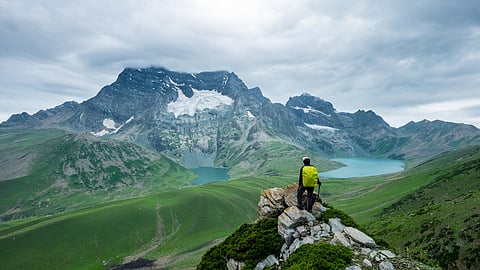
- Destinations
- Experiences
- Stay
- What's new
- Celebrating People
- Responsible Tourism
- CampaignsCampaigns
- SubscribeSubscribe
- Buy Now

The Kashmir Great Lakes Trek is a challenging 6-day hike spanning 75 kilometres in the Western Himalayas of Kashmir. On an average, the trek involves more than 12 kilometres of hiking per day. It begins at Sonmarg and ends at Naranag, suitable for individuals aged 15 and above. Considering the terrain, it is advisable for trekkers to have prior experience on this climb. The Kashmir Great Lakes Trek is amidst peaceful valleys and towering peaks of the Himalayas, attracting adventurers from across the globe. This journey takes hikers through some of the most arresting landscapes imaginable, offering a glimpse into the Kashmir region's rich history, diverse biodiversity and unparalleled beauty. It is a true treat for the senses, from stunning azure lakes to lush green meadows, snow-capped peaks, and ancient villages. Here’s all you need to know about the Kashmir Great Lakes Trek before you embark with your friends on this adventurous journey.
The Kashmir Great Lakes Trek is located in the northern Indian state of Jammu and Kashmir, which is often referred to as "Paradise on Earth." This region has a rich history influenced by various civilisations, including the Mughals, Sikhs, and British. The trek winds through the heart of the Kashmir Valley, offering breathtaking views of its famous lakes and surrounding mountains. It typically lasts 6-9 days and is graded as moderate in terms of difficulty. The elevation is around 13000 feet, and the distance covered is approximately 63 km. This trek offers a fulfilling experience where you can learn a lot about yourself physically and mentally. As a trekker, you'll experience the best of landscapes and adrenaline like never before. With proper preparation, this trek can be a happy and memorable experience you'll cherish forever.
The great trek stands out for its impressive array of wildlife and natural beauty. Trekkers will be surrounded by diverse flora and fauna, including rare species such as the Kashmir stag (Hangul), snow leopard, and black bear. The trek takes hikers through dense pine, oak, and rhododendron forests, where they will have plenty of opportunities to spot wildlife and watch birds. The trek's landscape is breathtaking, featuring seven stunning alpine lakes. Each lake offers a unique and unforgettable view, from the serene Vishansar Lake to the sparkling Gangbal Lake. Along the way, trekkers will also encounter vast meadows, towering glaciers, and cascading waterfalls, providing an immersive nature experience.
Along the trek, hikers can witness places like Sonamarg, a beautiful hill station that serves as the starting point of the trek. It is known for its lush meadows and snow-capped peaks, which offer a picturesque view. Nichnai Pass is another attraction on the route, a high mountain pass that provides stunning views of the surrounding valleys and glaciers. Vishansar Lake is the first of the seven lakes on the trek. It is known for its crystal-clear waters and serene surroundings, which make it a beautiful spot to rest. Gadsar Lake is at an altitude of 3,800 metres and is one of the most beautiful lakes on the trek. It is surrounded by snow-capped peaks and alpine meadows, which make it a breathtaking sight. Gangbal Lake is the largest and most famous lake on the trek. Locals revere it as a sacred place and offer breathtaking views of Mount Harmukh.
To trek in the Kashmir Great Lakes region, you must obtain permits from local authorities. These permits can be acquired through registered trekking agencies or directly from the Jammu and Kashmir Tourism Department. The ideal time to go on this trek is from June to September, during the summer months when the weather is mild and the trails are clear of snow. However, trekkers should be prepared for sudden changes in weather, such as rain and snowfall. While trekking, you can stay in tents or homestays operated by local villagers. It is recommended to bring your own camping gear and sleeping bags, although some trekking agencies may rent out equipment.
Although generally safe, the Kashmir Great Lakes Trek entails some risks associated with high-altitude trekking, such as altitude sickness and extreme weather conditions. To avoid these, it is crucial to acclimatise properly and remain hydrated. It is also essential to heed the advice of experienced guides.
The Kashmir trails are buried under snow in all seasons except from the beginning of July to the middle of September, the best time to trek.
The Kashmir Great Lakes trek begins at Shitkadi Village, which is about a three-hour drive from Srinagar and slightly ahead of Sonamarg.
Air: The nearest airport to Shitkadi Village is the Srinagar airport at 75 km.
Rail: Katra is the nearest rail head, or Jammu. Katra is 296 km from Shitkadi Village.
Road: You may also use a bus to reach Sonamarg, wherein the Shitkadi Village is located, from Srinagar.
